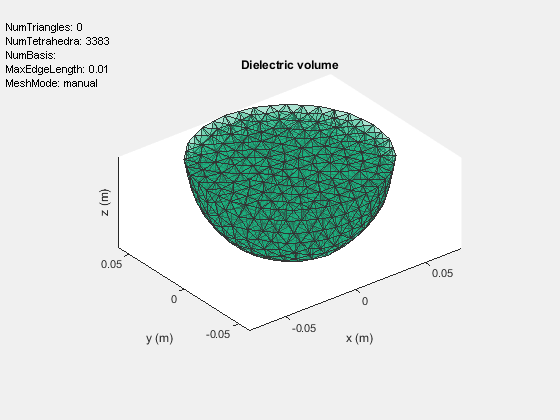dielectricLens
Description
The default dielectricLens object creates a Teflon dielectric lens
of radius 15 mm. Use this object to set the Element property of the planeWaveExcitation object. Further, set the
SolverType
property of the planeWaveExcitation object to "FMM". This
combination allows you to analyze the dielectric lens using the object functions of the
planeWaveExcitation object. Currently, only pattern function is supported for this combination.
Dielectric lenses are a type of lens antenna that uses the refraction of electromagnetic waves to modify the radiation pattern of a primary feed. They are often used in millimeter- and sub-millimeter-wave applications due to their compact size and flexible design. Dielectric lenses can have different shapes and refractive index profiles, depending on the desired output radiation pattern. They can be either homogeneous (uniform refractive index) or non-homogeneous (nonuniform refractive index). Some common examples of dielectric lenses are Luneburg lens, Maxwell's fish-eye lens, and delay lens.
Dielectric lenses are made of materials with high dielectric constants, such as polystyrene, polyethylene, and plexiglass. They can be integrated with various types of feeds, such as horn antennas, microstrip antennas, and waveguide antennas. They are useful for applications such as imaging, broadband communications, and automotive radar.
Creation
Description
d = dielectricLens
d = dielectricLens(PropertyName=Value)PropertyName is the property
name and Value is the corresponding value. You can specify several
name-value arguments in any order as
PropertyName1=Value1,...,PropertyNameN=ValueN. Properties that you
do not specify, retain their default values.
For example, d = dielectricLens(Radius=0.02) creates a dielectric
lens of radius 0.02 m.
Properties
Object Functions
Examples
References
[1] Fernandes, C.A., Lima, E.B., Costa, J.R. (2016). Dielectric Lens Antennas. In: Chen, Z., Liu, D., Nakano, H., Qing, X., Zwick, T. (eds) Handbook of Antenna Technologies. Springer, Singapore.
[2] Santos, R. A., G. L. Fre, F. B. Mejia, and D. H. Spadoti. Dual Millimeter Wave Reconfigurable Dielectric Lens Antenna. In 2018 International Conference on Electromagnetics in Advanced Applications (ICEAA), 489–92. Cartagena des Indias: IEEE, 2018. https://doi.org/10.1109/ICEAA.2018.8520440.
Version History
Introduced in R2024a
